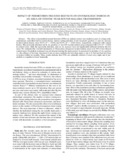Impact Of Permethrin-treated Bed Nets On Entomologic Indices In An Area Of Intense Year-round Malaria Transmission

View/
Date
2003-04Author
Gimnig, J. E
Vulule, JM
Lo, Terrence Q.
Kamau, Luna
. Kolczak, Margarette S
Phillips-howard, P A.
Mathenge, Evan M.
Ter Kuile, Feiko O.
Nahlen, Bernard L.
Hightower, Allen W.
Hawley, William A.
Language
enMetadata
Show full item recordAbstract
The effect of permethrin-treated bed nets (ITNs) on malaria vectors was studied as part of a large-scale, randomized, controlled trial in western Kenya. Indoor resting densities of fed Anopheles gambiae s.l. and An. funestus in intervention houses were 58.5% (P = 0.010) and 94.5% (P = 0.001) lower, respectively, compared with control houses. The sporozoite infection rate in An. gambiae s.l. was 0.8% in intervention areas compared with 3.4% (P = 0.026) in control areas, while the sporozoite infection rates in An. funestus were not significantly different between the two areas. We estimated the overall transmission of Plasmodium falciparum in intervention areas to be 90% lower than in control areas. Permethrin resistance was not detected during the study period. As measured by densities of An. gambiae s.l., the efficacy of bed nets decreased if one or more residents did not sleep under a net or if bed nets had not been re-treated within six months. These results indicate that ITNs are optimally effective if used every night and if permethrin is reapplied at least biannually.
Citation
Gimnig, J. E., Vulule, J. M., Lo, T. Q., Kamau, L., Kolczak, M. S., Phillips-Howard, P. A., ... & Hawley, W. A. (2003). Impact of permethrin-treated bed nets on entomologic indices in an area of intense year-round malaria transmission. The American journal of tropical medicine and hygiene, 68(4 suppl), 16-22.Publisher
University of Nairobi
